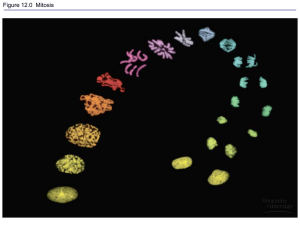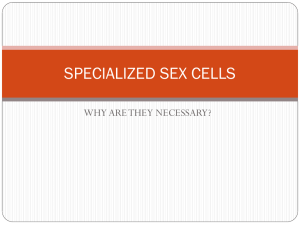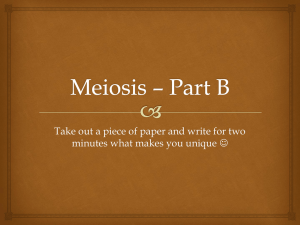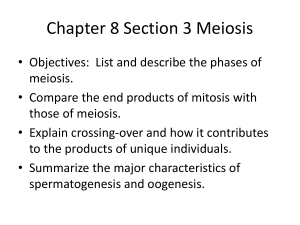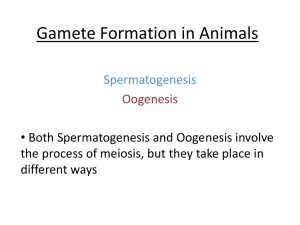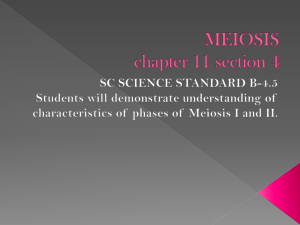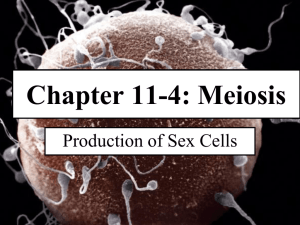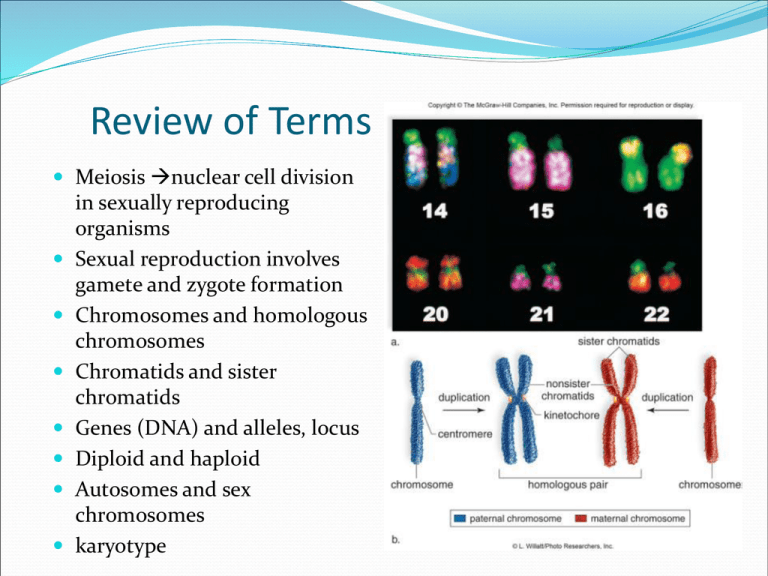
Review of Terms Used in Meiosis
Meiosis nuclear cell division
in sexually reproducing
organisms
Sexual reproduction involves
gamete and zygote formation
Chromosomes and homologous
chromosomes
Chromatids and sister
chromatids
Genes (DNA) and alleles, locus
Diploid and haploid
Autosomes and sex
chromosomes
karyotype
Meiosis-Main Source of Genetic Variability
• Formation of gametes (eggs and sperm)
• Sexual reproduction (Why?)
• Fertilization-union of sperm nuclei with egg
nuclei=diploid zygote (fertilized egg)
• Produces new cells with different DNA than parent
cell
• The gametes formed are haploid, they contain half
as much DNA as the parent cell
Brief Overview of Meiosis
• Chromosome movement and
•
•
•
•
•
division of cells is just like
mitosis
Diploid germ cell starts off in
interphase, DNA duplicated in
S phase
2 sets of divisions (2 PMATs)
called Meiosis I and II
No DNA duplication after
Meiosis I
Homologous chromosomes
separate in Meiosis I
Sister chromatids separate
during Meiosis II
Genetic
Variation
Crossing Over-exchange
of genetic material
between nonsister
chromatids of homologous
chromosomes prophase
Independent assortment
(random alignment)
metaphase, 223 combos
Fertilization male and
female gamete fuse, (223)2,
Plus 1 cross over: (423)2
different zygotes = 5 and 27
zeros
Meiosis I: reduction
DNA duplicated in Interphase (S)
Prophase I-chromosomes condense, centrioles duplicated and migrate to opposite
poles, microtubules grab on to chromosomes, nuclear envelope disappears,
crossing over occurs
Metaphase I-microtubules align chromosomes at equator; chromosome
organization is called Independent Assortment, the 2 kinetochores of the
duplicated chromosome are attached to the same kinetochore spindle fiber
Anaphase I- spindle apparatus (microtubules contracting) separates homologous
chromosomes; each chromosome still has 2 chromotids
Meiosis I: reduction
Telophase I-no formation
of nuclear envelope, cell
separates by cytokinesis
Interkinesis similar to
interphase, no DNA
replication
Meiosis II: division
Prophase II-centrioles
duplicate, move to opposite
pole, microtubules grab
chromosomes
Metaphase II-chromosomes
align at metaphase plate, like
mitosis except….?
Anaphase II-spindle
apparatus pulls sister
chromatids apart
Meiosis II
Telophase II-nuclear envelope
forms, cytokinesis results in 4
distinctly unique new cells
Animals gametes
Plants spores
Plants have an Alternation of
Generations: multicellular
haploid and diploid forms for
plants
Mitosis vs Meiosis
Mitosis vs Meiosis
Meiosis= 2 chromosomal divisions; Mitosis= 1
Meiosis=4 daughter nuclei; Mitosis=2
Following meiosis, 4 daughter cells are haploid (1/2
chromosome # of parent cell; following mitosis the
daughter cells have same chromosome #
Following meiosis daughter cells are genetically
distinct form each other and parent cell; following
mitosis daughter cells are genetically identical to each
other and parent cell.
Where are Gametes Produced?
In Humans:
Sperm testis, eggs
ovaries
In Plants:
Sperm anthers, eggs
ovaries
Life cycle of plants and
animals consists of both
mitosis and meiosis
Sperm + egg zygote
Adult gametes
Spermatogenesis
Formation of sperm
through meiosis
Spermatogonium
primary spermatocyte
secondary spermatocyte
spermatids sperm
Produces 4 genetically
distinct gametes
Sperm production begins
with male puberty and
continues
Oogenesis
Formation of eggs through
meiosis
Oogonium primary oocyte
secondary oocyte + 1 polar body
ovum + 3 polar bodies
Polar bodies are smaller than
ovum and are the result of
unequal cytoplasmic division
Egg production in utero (fetus has
many primary oocytes), mature at
puberty
Secondary oocyte arrests at
metaphase 2, leaves ovary, enters
oviduct
Entry of sperm triggers
completion of meiosis II
Why must an egg be large?
Mitosis vs. Meiosis
Mitosis
Meiosis
somatic cells
growth and repair
diploid diploid
1 cell 2 cells
same DNA as parent
cell
1 set of divisions (1
PMAT)
germ (sex) cells
gamete formation
diploid haploid
1 cell 4 cells
DNA different than parent
cell
2 sets of divisions (2
PMATs)
Changes in Chromosome Numbers
Nondisjunction-one or
more pairs of
chromosomes fail to
separate during anaphase
of mitosis or meiosis
Aneuploidy-one extra or
one less chromosome
Polyploidy-having 3 or
more chromosomes
If nondisjunction occurs
in Anaphase II of meiosis,
how many chromosomes
will each gamete have?
Changes in Autosome Number: Down’s
Syndrome
Nondisjunction in
reproductive cells that give
rise to gametes
Extra chromosome #21trisomy visible in karyotype
mildsevere mental
retardation, heart defects,
abnormal skeletal
development
1 out of 1100 births
Increased risk as age of
mother at conception
increases
Changes in Sex Chromosome
Number
Nondisjunction during gamete
formation
Turner’s Syndrome-XO, female, short,
sterile, nonfunctional ovaries, 1 out of
10,000 newborn girls
Klinefelter Syndrome-XXY, male,
taller, sterile, abnormal testis, mild
retardation, can be asymptomatic, 1 out
of 5001000 newborn boys
Jacob’s Syndrome-XYY, male
nondisjunction in sperm, taller, mild
retardation, phenotypically normal,
asymptomatic, 1 out of 1000 newborn
boys
Poly-X females-usually no mental
retardation, 1 out of 1500
Barr bodies- inactive X chromosomes
SRY gene – male determining factor
Changes in Chromosome Structure
Change in physical structure of chromosome
Rare spontaneous occurrence
Can lead to genetic disorder or abnormality
Can be caused by viruses, chemicals, radiation
Types of Chromosome Structure
Changes
Duplication-parts of
chromosome repeated many
times
Inversion-alteration of position
and sequence of genes in a
chromosome
Translocation-part of one
chromosome is transferred to a
non homologous chromosome
Deletion-loss of part of a
chromosome
Deletion Syndromes
Williams Syndrome - chromosome 7 loses part of its end “pixie”
looking, turned up noses, wide mouths, small chin, large ears
Cri-du-Chat Syndrome- “cry of the cat” loss of part of chromosome #5
results in abnormal larynx and mental retardation
Translocation Syndromes
Alagille syndrome
transfer between 2 and
20, distinctive face,
abnormalities of the eyes
and internal organs
Chronic Myelogeneous
Leukemia, transfer
between #9 and #22,
“Philadelphia
Chromosome”
Burkitt lymphoma
translocation of
chromosome #8 and 14,
tumors of the jaw


